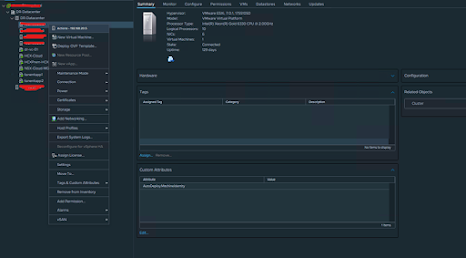Install and configure vRealize Operations Manager
Lets understand what is vRealize Operations Manager?
vRealize Operations deliver a unified management platform to optimize, plan, and scale hybrid cloud deployments from applications to infrastructure, powered by AI/ML, as a service.It is also called as vROPS (vRealize Operations manager).
vRealize Operations Manager comes as a virtual appliance that is to be deployed in your management cluster if you have one. It can be installed in a number of ways, tailored to your environment’s size and complexity.
What is use cae of vROPS in Privare and Hybrid Cloud ?
In simple word , vROps is a tool from VMware that helps IT administrators monitor, troubleshoot, and manage the health and capacity of their virtual environment. The VMware vRealize Operations (vROps) Management Suite provides complete information about performance, capacity, and health of our infrastructure.
What are the some other benifts which you can get with vROPS ?
It enables proactive monitoring, capacity planning, and automation, allowing organizations to manage and scale their virtual infrastructure effectively. Additionally, vROps offers integration with other VMware solutions, such as vSphere and vSAN, to provide a holistic view of the entire virtual environment.Few other benefits which will you recommendation for VM sizing like undersized VMs,Oversized VMs ,High vCPU vonfigured with VMs and like that lots of other recommendations which you can use to manage your infrastructure.vRealize Operations components and Architecture?
In a single-node installation, the master node manages itself, has adapters installed on it, and performs data collection and analysis.
Replica Node: Replica Node as name defined is copy of Primary Node. During a failure event of the master node, the master replica DB is promoted to a full read/write master. Although the process of the replica DB's promotion can be done online, the migration of the master role during a failover does require an automated restart of the cluster.
Data Node : It provides the core functionality of collecting and processing data and data queries as well as extending the vROps cluster by being a member of the GemFire Federation, which in turn provides the horizontal scaling of the platform. Specifically, they host adapters performing data collection as well as analysis. Larger deployments usually include adapters only on the data nodes so that master and master replica nodes can be dedicated to cluster management.
Remore Collector Node: The remote collector role is for remote sites or secure enclaves. Remote collectors do not process data themselves; instead, they simply forward metric data to data nodes for analytics processing. remote collector node that can span firewalls, collect data from a remote source, reduce bandwidth across data centers, and/or reduce workload on the vROps cluster.
Witness Node : Witness node is play his role ,If network connectivity between two fault domains is lost, the witness node acts as a decision maker regarding the availability of vROps.
vRealize Operations Large Deployment Profile Architecture:
Sizing tool for deployment of vROPS nodes as per your environment
You have to choose the version which you are going to deploy then need to provide details about workload like how many datacenter you have ,vCenter ]s ,Cluster ,Object ,etc…
Below is the sample snap for you:
Deployment of vRealize Operations appliance or nodes:

also provide url.

4.Next you have to choose the compute resource where you want to deploy vROPS nodes which will utilize the compute resource of cluster.

5.Now Review all the details related to appliance like version, size on disk ,product and etc and click Next.
7. Now her we must choose the size of node. If you remember we have provided you vROPS sizer tool which will help you to determine what kind of node you need to deploy as per infrastructure like how many object, cluster size, vCenter etc.. I am deploying in Lab so choosing small node.

8.Here we have to select the datastore where vROPS appliance will use, You can also change disk format as per your requirement.

9. Now we must choose the port group or network from which vROPS manager will get ip and using which it will communicate will other nodes as well as management VMs (like vCenter, ESXi..)
10.In Customize Template choose the Time zone, gateway network and DNS name and click Next .Make sure DNS entry for all nodes should be on place before deployment .
11.Last Review all the details which you provided in all previous steps and once everything is fine Click on Finish. Deployment of OVF will take 15-20 minutes .

12.After Deployment of OVF will complete ,Go to vCenter and check the vROPS cm console it will give you FQDN which we need to access on browser to start stage 2 and finish the configuration Part .


































































